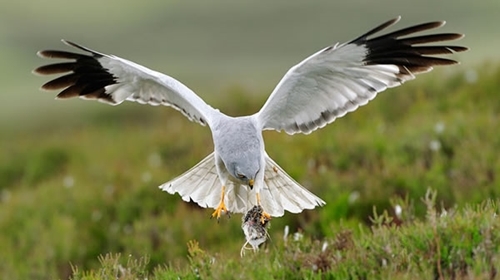In January Defra launched its Hen Harrier Action Plan, which contains six key elements. One of these, brood management, was included after considering the key findings of over 20 years of RSPB/GWCT research. The science is important. Science has informed why brood management is included in the plan – we need a plan that manages our moors for both harriers and driven red grouse shooting. The reason it is not an either-or choice between harriers and grouse became clear during and after the Joint Raptor Study (JRS), undertaken at Langholm Moor in Dumfriesshire.

The lose/lose situation has been proven by research
On the grouse moors at Langholm between 1992 and 1997 GWCT scientists monitored the increase of hen harriers from 2 to 20 pairs in six years. Shooting was abandoned because hen harriers ate over a third of all the grouse chicks that hatched, preventing grouse recovery. With no shooting, the local culture, economy and employment suffered and the control of generalist predators ceased. By 2003, 20 harrier nests were back down to two and numbers of breeding grouse and waders had more than halved. Predation was identified as the most likely cause of all these declines, including the harriers. Grouse moor managers felt their worst fears had just been proven – a real lose/lose situation.
Defra wants sustainable moorlands
The Hen Harrier Action Plan published by Defra in January has two success criteria: more hen harriers in England and that “the harrier population coexists with local business interests and its presence contributes to a thriving rural economy”. Given that we know hen harriers can make a grouse moor uneconomic in just a few years, we feel it is entirely sensible the plan includes an already tested raptor conservation tool to help hen harriers and red grouse thrive in the interests of both: brood management.
Brood management – helps prevent lose/lose
Brood management, a successful raptor conservation tool for over 40 years, is in the plan because both the GWCT and RSPB know that once a moor cannot be driven for grouse, it is ferociously hard and expensive to recover it as a fully functioning moorland ecosystem, with social, economic and environmental outputs. Over the last seven years the colossal attempts to recover the grouse moor at Langholm, which have included diversionary feeding up to 12 harrier nests a year, have failed to produce enough grouse to persuade a typical shooting tenant to invest in the sheep management, heather recovery and fox control needed to support harriers, let alone grouse. To avoid multiple lose/lose situations we need to ensure we have mechanisms in place before, not after, moors become uneconomic.
 Free weekly newsletter
Free weekly newsletter
Stay updated on this story and get all the latest GWCT blog updates and news delivered straight to your inbox each Tuesday.
Sign up FREE to the Weekly GWCT Newsletter >